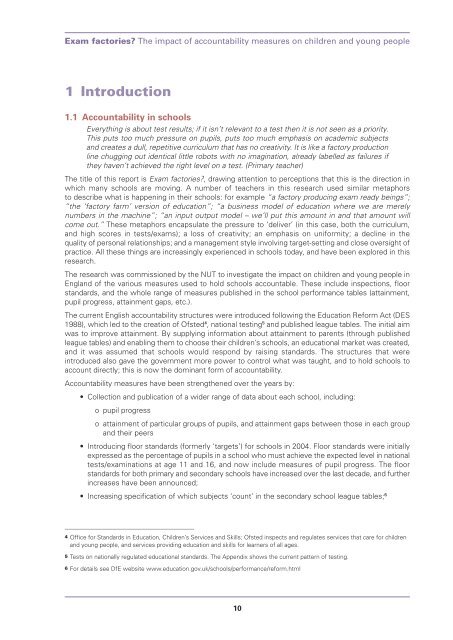exam-factories
exam-factories
exam-factories
You also want an ePaper? Increase the reach of your titles
YUMPU automatically turns print PDFs into web optimized ePapers that Google loves.
Exam <strong>factories</strong>? The impact of accountability measures on children and young people1 Introduction1.1 Accountability in schoolsEverything is about test results; if it isn’t relevant to a test then it is not seen as a priority.This puts too much pressure on pupils, puts too much emphasis on academic subjectsand creates a dull, repetitive curriculum that has no creativity. It is like a factory productionline chugging out identical little robots with no imagination, already labelled as failures ifthey haven’t achieved the right level on a test. (Primary teacher)The title of this report is Exam <strong>factories</strong>?, drawing attention to perceptions that this is the direction inwhich many schools are moving. A number of teachers in this research used similar metaphorsto describe what is happening in their schools: for <strong>exam</strong>ple “a factory producing <strong>exam</strong> ready beings”;“the ‘factory farm’ version of education”; “a business model of education where we are merelynumbers in the machine”; “an input output model – we’ll put this amount in and that amount willcome out.” These metaphors encapsulate the pressure to ‘deliver’ (in this case, both the curriculum,and high scores in tests/<strong>exam</strong>s); a loss of creativity; an emphasis on uniformity; a decline in thequality of personal relationships; and a management style involving target-setting and close oversight ofpractice. All these things are increasingly experienced in schools today, and have been explored in thisresearch.The research was commissioned by the NUT to investigate the impact on children and young people inEngland of the various measures used to hold schools accountable. These include inspections, floorstandards, and the whole range of measures published in the school performance tables (attainment,pupil progress, attainment gaps, etc.).The current English accountability structures were introduced following the Education Reform Act (DES1988), which led to the creation of Ofsted 4 , national testing 5 and published league tables. The initial aimwas to improve attainment. By supplying information about attainment to parents (through publishedleague tables) and enabling them to choose their children’s schools, an educational market was created,and it was assumed that schools would respond by raising standards. The structures that wereintroduced also gave the government more power to control what was taught, and to hold schools toaccount directly; this is now the dominant form of accountability.Accountability measures have been strengthened over the years by:• Collection and publication of a wider range of data about each school, including:o pupil progresso attainment of particular groups of pupils, and attainment gaps between those in each groupand their peers• Introducing floor standards (formerly ‘targets’) for schools in 2004. Floor standards were initiallyexpressed as the percentage of pupils in a school who must achieve the expected level in nationaltests/<strong>exam</strong>inations at age 11 and 16, and now include measures of pupil progress. The floorstandards for both primary and secondary schools have increased over the last decade, and furtherincreases have been announced;• Increasing specification of which subjects ‘count’ in the secondary school league tables; 64 Office for Standards in Education, Children’s Services and Skills; Ofsted inspects and regulates services that care for childrenand young people, and services providing education and skills for learners of all ages.5 Tests on nationally regulated educational standards. The Appendix shows the current pattern of testing.6 For details see DfE website www.education.gov.uk/schools/performance/reform.html10


